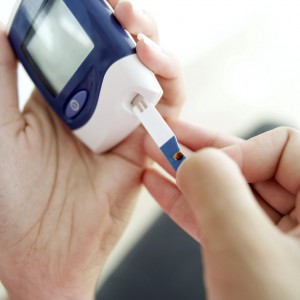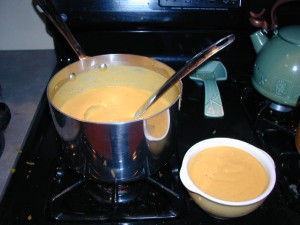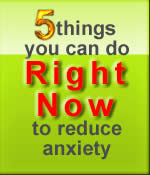Food Allergies, Digestion, & Body Odor?
 When I was at my lowest point, not only did I have relentless anxiety but horrendous body odor. Gross, but honest! So what’s the connection between anxiety and putrid body odor? Could be many things that cause the body odor like stinky underarm bacteria – lack of showering, too much garlic and curry, out of control diabetes, kidney dysfunction, or…. protein indigestion. The latter was my case, some of it linking back to food allergies.
When I was at my lowest point, not only did I have relentless anxiety but horrendous body odor. Gross, but honest! So what’s the connection between anxiety and putrid body odor? Could be many things that cause the body odor like stinky underarm bacteria – lack of showering, too much garlic and curry, out of control diabetes, kidney dysfunction, or…. protein indigestion. The latter was my case, some of it linking back to food allergies.
When my intestines were so damaged from food allergies, I couldn’t digest foods properly. This was especially the case with protein. Undigested protein can lead to a lot of smelly things like armpits and rancid gas. Sweat is unusually pungent when ammonia waste from the protein exudes from the skin. Because I had an allergy to dairy protein (especially casien), I would really stink after eating cheese. WOOOEEE, watch out!
So what does this have to do with anxiety relief? If the intestinal lining is compromised from adrenal fatigue, then things like food allergies creep in. When that happens, food doesn’t get digested and absorbed properly. Result – nutritional deficiencies. No protein digestion + no amino acid absorption + no raw material to make neurotransmitters = anxiety, panic attacks, or other things like that. At lease that was my case. When I spruced up my digestion, I felt a whole lot better mentally and emotionally. Stinking less was the bonus.
Other deficiencies occur too that contribute to mental un-wellness, but protein is the case here. We can eat a lot of it, but it’s not what we eat it’s what we absorb! What did I do to help this? My doctor tested me and found which free form amino acids I needed to take until my intestines were repaired. To repair my intestines, this is what I (Jen Crippen) did:
- Eliminated all foods that were causing further damage to the intestines. For me it was dairy, wheat, soy, corn, night shades (potato, eggplant, peppers), and caffeine
- Strengthened the adrenals
- Took digestive enzymes. My favorite are 1 Essentialzyme, 1 Polyzyme and 1 Detoxyme with every meal.
- Super strain pro-biotics to replenish the intestines with good bacteria. This stopped much of the putrification and the formula I use (Life 5) also kills yeast rhizomes. I’ll have to blog about my candida yeast adventure in the future!
- Drink a lot of water to help get the toxins out of my body.
- Used anti-bacterial natural soap to kill nasty bacteria in my pits.
- Ate chlorophyll rich foods to help combat the acidic condition in my body that contributed to the body odor. Anything super green like spinach, broccoli, kale, chlorella, Multi-Greens, wheatgrass, etc.
Oh, by the way – when we don’t digest protein well our blood sugar is all over the place too. Hence, another factor which contributed to the extreme hypoglycemia. Who’d think body odor is linked anxiety therapy?
Adrenal Fatigue & Hypoglycemia
Recently I did a post on a chat board for hypoglycemia caused by adrenal fatigue. I felt the post was so good, that I decided to put in on this blog.
Hi Everyone,
I’ve been on this board following the conversations for quite a while but haven’t posted. Colleen encouraged me to write a post about adrenals and blood sugar. Looking back, my blood sugars have probably been ‘whacked’ since the onset of puberty.
A few years ago I became extremely intimate with adrenal fatigue. I was very very ill to the point of incapacitation. Through much trail and error as well as research I was able to get myself well. Oh, I also had an amazing doctor who was my partner back to wellness. For me, one of the biggest symptom of the adrenal fatigue was severe hypoglycemia. Some of the other biggies were food allergies, chronic pain, hormone imbalance, and anxiety/panic attacks.
Why are hypoglycemia and adrenals tied together? The adrenals monitor blood sugar levels via adrenaline, cortisol, HGH. When levels plummet, the adrenals want to save the brain from glucose starvation and blast out the hormones just mentioned. Blood sugar instability via diet is THE WORST thing for the adrenals – lots of highs & lows. The weaker the adrenals – the worse the hypo. It is a vicious cycle. To stabilize sugar levels for adrenal recovery we need lots of healthy fats (coconut oil, butter, avocados, nuts, dairy if not allergic) and high quality protein (meats, fish, nuts, dairy, low glycemic protein drinks, eggs).
Now the carb debate. To carb or not to carb? We need carbs. They are critical for the absorption of certain amino acids. They also give us immediate fuel until protein can fat get further in the digestive process and converted into energy source. EVERYBODY will be different in the types of carbs they can do. Some people will be able to do whole grains, some not. I am one of those people who has food allergies to almost all carbs (corn, wheat/gluten, potato) and for whatever reason I cannot do the rest (rice, millet, quinoa).
However, I do eat carbs from low glycemic fruits like apples, berries, cherries, and cranberries w/o a problem. I get most of my carbs via squash: pumpkin, spaghetti, zucchini, acorn, butternut, etc. But I never eat carbs alone, they are always tied in w/ a protein/fat. Example – apples with almond butter, pumpkin soup (http://naturalanxie tytherapy. com/521/yum- o-anti-insulin- resistance- soup-recipe/). Finding balance on how to eat carbs so they burn long and slow is a hypoglycemics greatest challenge!
My little rule that works for my students is when you look at your dinner plate, the carb portion should NEVER be larger than the non-starchy vegetable or meat. Plus, that carb should be low glycemic like quinoa, wild rice (even brown is high glycemic), amaranth, wheat berry salad, beans or whatever! I hope that makes sense, it’s tough w/o a pictorial to get this concept across. So, if you have 1/2 cup of quinoa – you need at least 1/2 cup of non starchy veg and 1/2 cup of protein.
To clarify, starchy carb foods are: corn, potato, grains, parsnips, beets, pumpkin, hard skinned squash, etc. Non-starchy: anything of bold color (peppers, onions, spinach, zucchini, lettuce, cabbage, celery, asparagus, etc) Borderline: carrots, peas.
One thing that can throw a wrench into this idea of eating is food allergies, it complicates the whole darn thing. Not going into that in this post – it’s already long enough. But what sucks worse than being a hypoglycemic is being one who can’t eat dairy, corn, soy, wheat/gluten, pinto beans, and peanuts. GRRRRR
Now for adrenal recovery.
Everyone’s deficiencies are going to be different. I did an intro audio on adrenals that is posted on my blog and everyone can listen w/o a charge. http://naturalanxie tytherapy. com/181/181/
There are some critical nutrients for the adrenals to recover. Over 95% of people have this to some degree. It is the #1 contributor to hypoglycemia! !!!!! Also, issues w/ the liver but I won’t go there right now.
Here’s a list of nutrients important for recovery, this is a place to begin and some of these require testing to determine severity of deficiency. I had EXTREME adrenal fatigue and have been digging myself out of it for over 2 years. Doing very well I might add 🙂 This may seem like a lot of stuff, but when the body becomes so deficient it takes so much to get things back into balance. Then we can start eliminating these nutrients as reserves become full again.
1. Vitamin C
2. Magnesium
3. Zinc
4. B Complex (especially B12, B6, B5)
5. Adaptogen herbs (ashwaganda, rhemannia, licorice, eleuthero, rhodiola, maca, wolfberries, nutmeg) Depending on the cortisol test will determine which of these are best.
6. DHEA – some people may need this based on testing
7. Amino acid therapy – determined based on testing
8. Enzymes & probiotics – if the adrenals are burned out, guaranteed the gut is off whack. Especially if HYPO!
9. Minerals – especially trace mineral complex
10. Vitamin D3
11. Omega 3’s
12. Glandular support – pituitary, hypothalamus, thyroid, gonad can either be glandulars or nutrient specific to feed those glands
13. REST!!!!! @ least 8 hours
14. Protein – feeds the adrenals. But need the enzymes to digest it 🙂
15. Salt
Secondary “Issues” that stem from adrenal fatigue: irritable bowel, depression, anxiety, panic attacks, hypoglycemia, food allergies, auto-immune diseases (fibromyalgia, lupus, mixed connective tissue disorder), insulin resistance, obesity, thyroid imbalance, sex hormone imbalance, blood pressure issues (esp. low), temperature regulation problems (hot & cold), asthma, obesity, memory problems, impaired immunity, etc. Just about everything!
Couple of fun and easy ways to determine adrenal issues. 1. Stick out your tongue while looking in a mirror. Does it quiver? 2. Shine a flashlight in your eye. Can the pupil hold the contraction or does it slowly open? Some people it abruptly opens and closes and can’t hold either. I’ve seen this in extremely fatigued people. 3. When getting up quickly from laying or sitting – dizziness occurs. 4. Bags under the eyes. 5. Vertical cracking and splitting of the nails.
These home tests are not meant to replace 12 Hour cortisol and DHEA tests that determine adrenal imbalances. Please find a doc that can be your partner in recovery!
I will say that my blood sugars are behaving 😉 If I take my supplements, manage stress, have fun, sleep, eat right I do VERY well. I feel better than I have in my whole life – energy, not crabby, sex drive returned, hormones balanced, 55 pounds of weight loss, skin is flawless, etc. It wasn’t easy, but worth it!
I know this post has a lot of holes in it. I probably missed a few nutrients and maybe my food combining description is unclear. But this gives ya’ll a place to start asking me questions if you’d like 🙂 I cannot even imagine the grammar and spelling error – forgive me for those too. It’s already taken me over an hour to write this post and I have things to do and places to be!!! ha ha
Be well,
Jen
Help Anxiety, No SAD Times this Winter!
Now that the clocks have been turned back the days feel very short. Darkness will fall earlier everyday until December 21st, then the days start getting longer. This time of year many of us (including myself) start to feel the winter blues. The past few years I have made a few changes to help me from feeling the effects of SAD (seasonal affective disorder). Here are a couple of tips as part of my anxiety therapy!
With less natural light, the body makes less vitamin D3. D3 is one of the critical vitamins that combats depression, anxiety, SAD, and other mental ‘stuff’. A simple search on the internet for “D3 SAD” or “D3 Depression” “D3 anxiety” will yield a ton of wonderful information on the connection of this vitamin and how how it can help anxiety. To raise my D3 levels, I take about 4000 IU a day through the winter months. D3 can also be made from the sun, what a great excuse to go on a Caribbean vacation right after New Years! Wonder if I can deduct it as a medical expense?
I also try to get out in the sun a bit during peak daytime hours. D3 is made when the sun hits the skin. Sunlight also increases serotonin levels in the brain when it hits the iris. The neurotransmitter serotonin is on of the most important feel good brain chemicals. Later in the day, it is converted to melatonin which prepares us for a good night’s sleep. If it’s not possible to get out into the sun, some people have used full spectrum light bulbs and have had great – uplifting results.
Omega 3 fatty acids are another weapon in my arsenal to help SAD. My favorite source of omega 3’s is cod liver oil, the lemon flavor! My goal is to get about 4 grams a day. This helps my brain feel happy! Plus, I remember things better, my joints hurt less, and skin looks fabulous. Funny how people who live in areas with funky daylight times such as Alaska and Norway have an abundance of fish that can supply them with D3 and omega 3’s? Nature is awesome!
The last thing I do is diffuse essential oils. Essential oils from plants have been studied heavily for their properties to lift and balance mood. I have a house diffuser and use a blend called Citrus Fresh. If I start to feel the blues and need extra support, I break out The Feelings Kit. What I would do without these I don’t know, they helped keep me glued together when the anxiety and panic attacks were at it’s worst. People say, “You always know when Jen Crippen is around – it smells wonderful!”. Besides smelling good, they make me feel happy and help anxiety!
Anxiety Cause Revealed
In my September 28th post I shared how hormone imbalances can be an anxiety cause. The last month or so I had been experiencing a bit of anxiety again. Not panic attacks, just waves of anxiety now and then along with the wonderful feeling of spaciness. So, I went to the doc and promised to share the findings.
About a week ago I received a call with the results. Hormones were perfect! I was delighted because I had been working on balancing my hormones for years. However, that meant the hormones weren’t causing anxiety. About a month prior test results came back saying my neurotransmitters (brain chemicals) were balanced too. Now what? Then the doc said, “Did you know your blood sugar was only 58?”.
Hypoglycemia (low blood sugar) strikes again. Often, along with adrenal fatigue comes erratic blood sugar levels and insulin resistance. When my blood sugar levels plummet, I feel very anxious, spacey, and get strange thoughts. This is due to the lack of glucose in my brain as well as the rush of adrenalin my adrenals put out to raise up blood sugar levels.
I will soon post more on one of the #1 anxiety causes – hypoglycemia. For now, I must keep checking my blood sugar levels with my handy glucometer, eating every few hours, and strengthening my adrenals. Adrenal fatigue and blood sugar problems are all part of the anxiety web. I love that eating more food is part of my anxiety therapy!
Yum-O Anti Insulin Resistance Soup Recipe!
A marvelous creation was birthed on Oct. 3rd, 2009 – a simple soup that is so good you’ll be cheering “YUM-O” after your first spoonful!
You’ll see in many blog posts that one of the major causes of the anxiety and panic attacks for me were food allergies and blood sugar imbalances. My sugars would swing high and then plummet through the floor. When this happened, a panic attack would rush in from nowhere and I’d be flipping out for 20 minutes. So, I strive to eat foods in combination that will keep my blood sugars even Steven.
With this pumpkin soup, you have very complex carbohydrates from the pumpkin, substantial fat from the coconut milk, and secret blood sugar balancing ingredients to make it “oh-so-good”. Combining ingredients such as complex carbs with fat and/or protein makes our blood sugar and adrenal hormone levels very happy. Result: less anxiety!
This soup is also rich and creamy without the dairy.
This is how you make it:
2 small pumpkins (about 6″ in diameter)
1 1/2 cans of full fat coconut milk (21 ounces)
1 tsp salt
1/2 tsp pepper
1 drop of therapeutic grade Cinnamon Essential Oil
Chinese 5 spice
3 to 4 drops of therapeutic grade Ocotea Essential Oil
Preheat oven to 375 degrees.
Pumpkin Prep: Wash, cut in half, scrape out seeds (roasted pumpkin seeds are also great anti-anxiety foods!). Lightly sprinkle flesh side of pumpkin with Chinese 5 spice then place halves flesh side down in a covered roasting pan. I like to put just enough water in my roasting pans to cover the bottom, it helps steam the pumpkins and keeps them from drying out. Roast for 45 minutes to an hour or until a fork can easily poke holes through the tough outer skin. Flesh should be tender and flake out easily. Allow pumpkin to cool enough to be handled comfortably.
Take roasted pumpkin and scrape out flesh into a large pot (4 qt or larger). Add coconut milk, salt, pepper, cinnamon, and ocotea. Run a hand blender through soup until creamy and smooth. If the soup is too thick, add about 1/2 cup of water or coconut milk.
After well blended, heat soup on stove top before serving. Do not boil. Season with additional salt or pepper if desired.
The secret ingredients for balancing sugar and helping with our sane feelings? OCOTEA and CINNAMON essential oils. Cinnamon has been researched heavily for it’s ability to balance blood sugar levels and help insulin resistance. Ocotea’s potential to harmonize blood sugar levels has only been discovered recently. About a month ago my blood sugars were a little off and I started to feel restless. When I started using ocotea in my morning smoothies and a few drops before bed, my levels balanced out again and I felt more grounded and relaxed. I was so happy that something so simple worked so fast for me!
Pumpkin soup is really delicious anxiety therapy!












